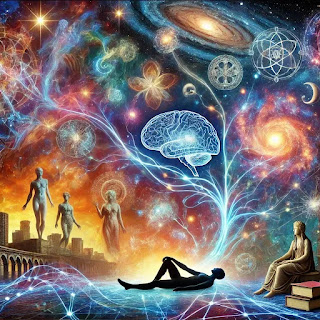The Power of Imagination and Thoughts!
The power of imagination and thoughts is a fundamental aspect of human cognition and creativity, with profound impacts on personal growth, innovation, and even physical well-being. Let’s break this concept down in detail:
1. Imagination and Its Role
Imagination is the ability of the mind to create mental images, scenarios, or concepts that do not physically exist. It allows us to explore possibilities, anticipate outcomes, and innovate. Imagination influences several key areas:
Problem Solving: By imagining different scenarios, people can foresee potential solutions and consequences, helping them solve complex problems.
Creativity: Imagination fuels the creative process in art, writing, science, and technology. It helps artists envision new forms, writers create stories, and inventors design innovative tools.
Empathy: It allows us to put ourselves in others' shoes, understand their perspectives, and emotionally connect to their experiences.
Goal Setting: When we imagine our future, we can set clearer, more ambitious goals. This mental visualization can motivate us to take actionable steps toward achieving them.
2. Thoughts and Their Influence
Thoughts are the cognitive processes that shape how we interpret the world. They affect our emotions, behavior, and even physical health. Here’s how thoughts hold power:
Shaping Reality: Our thoughts frame how we perceive experiences. Positive thinking can lead to optimism and resilience, while negative thinking may foster stress, anxiety, or depression.
Self-fulfilling Prophecies: If we believe something strongly, our behavior often aligns with that belief, making it more likely to come true. For example, thinking "I will succeed" boosts confidence and effort, increasing chances of success.
Mind-Body Connection: Thoughts can have a real physical impact on the body. For instance, stress or negative thinking can raise cortisol levels, potentially leading to health issues like high blood pressure. On the other hand, positive thoughts can promote relaxation and improve overall health.
3. Connection Between Imagination and Thoughts
Imagination and thoughts work together to influence behavior, decisions, and creativity. Here's how they intersect:
Visualization and Achievement: Athletes, for instance, often use visualization techniques, where they imagine themselves successfully completing a task (like scoring a goal). This not only boosts confidence but also primes the brain for actual success.
Innovation and Thought Expansion: Imaginative thinking can stretch the boundaries of conventional thought, opening the door to new ideas. Visionaries in science and art often use imaginative thoughts to break from tradition and create something revolutionary.
Emotional Regulation: Imagination can be used to change thought patterns and regulate emotions. Techniques like guided imagery or creative visualization are often employed in therapeutic settings to help individuals cope with trauma, stress, or anxiety.
4. Harnessing the Power of Imagination and Thought
To maximize the potential of your imagination and thoughts:
Practice Visualization: Regularly visualize your goals, successes, and ideal outcomes. This can help clarify your intentions and increase motivation.
Challenge Negative Thinking: Be aware of unproductive or harmful thought patterns. Replace them with positive, empowering thoughts to foster better mental health and well-being.
Creative Exercises: Engage in activities that stimulate your imagination, such as brainstorming, creative writing, or even daydreaming. These exercises keep your mind flexible and innovative.
Mindfulness and Thought Awareness: Developing mindfulness helps you observe your thoughts without judgment, allowing you to choose which thoughts to act upon and which to let go.
The power of imagination and thoughts is vast, impacting everything from creativity and innovation to health and emotional well-being. By harnessing this power, you can shape your life, your relationships, and your environment in profound ways.




Comments